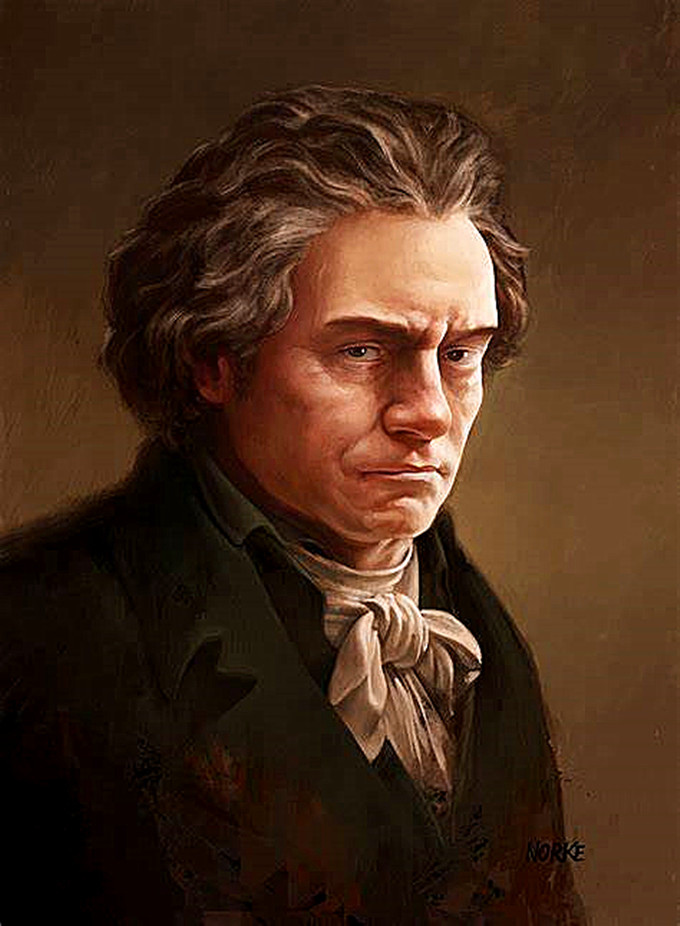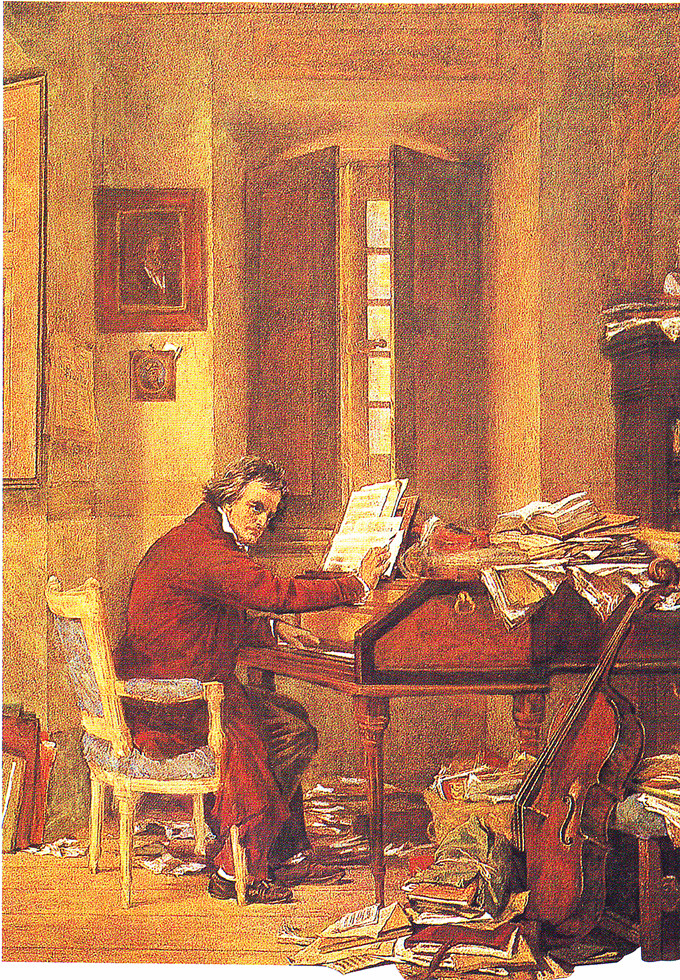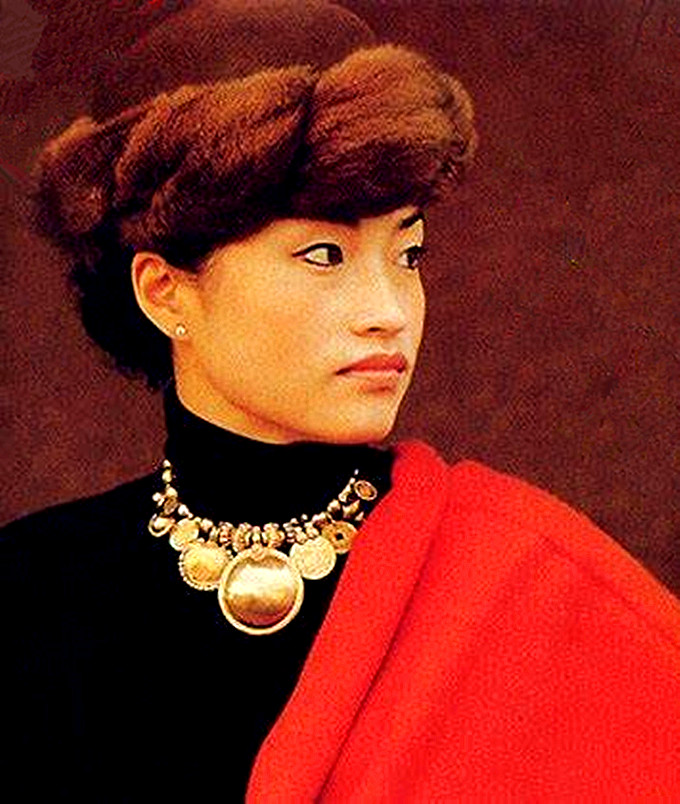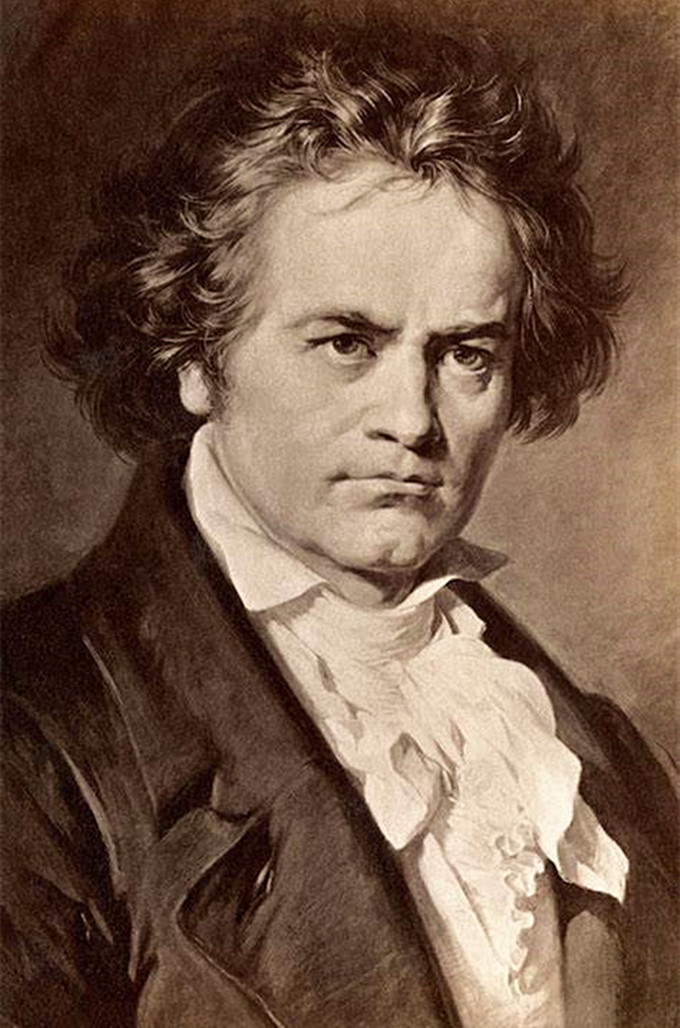| |
|
|
|
|
|
|
|
|
|
|
|
| |
| |
 |
|
| |
田润德
编译文/图 2020-03-26 18:36 |
|
| |
|
|
|
|
| |
 |
|
|
|
| |
路德维希·凡·贝多芬 (Ludwig van Beethoven 1770—1827) |
|
|
|
| |
|
|
|
|
| |
郑京和演奏《贝多芬小提琴协奏曲
》指挥:滕斯泰特
|
|
|
|
| |
|
|
|
|
| |
音乐历史上的今天
1827年3月26日,1827年3月26日下午,惊雷滚滚,道道闪电划破了茫茫长空!昏睡中的贝多芬永远地闭上了双眼。
路德維希·凡·貝多芬 (Ludwig van Beethoven,
1770年12月16日—1827年3月26日)德國音樂家,世稱樂聖,家貧苦,四歲,其父令其習豎琴,十壹歲,隨母至荷蘭,設旅行音樂會,以善奏鋼琴著名,十七歲,赴維也納,學於莫紮特之門,尋以母喪返德,於其故鄉波昂教授音樂,一方致力於文學,一七九二年,再至維也納,得海頓之指教,藝益精進,聲譽亦盛極壹時,三十歲後,耳漸聾,然作風轉趨入崇高之境,幽怨悲愴,無壹非氏心靈所流露,作品最著名者,有鋼琴曲《月光》,序樂《科立奧雷那》(Coriolanus),歌劇《飛對略》(Fidvlio),神劇《橄欖山》(Mount
of
Olives)等,而其最大成功則在交響樂曲,有《英雄》《田園》《運命》等九篇,其復雜者須千余人合奏,影響於後來音樂界甚巨。——見《中華民國大辭海》
他短小臃肿,外表结实,生就运动家般的骨骼。一张土红色的宽大的脸,到晚年才皮肤变得病态而黄黄的,尤其是冬天,他关在室内远离田野的时候。额角隆起,宽广无比。乌黑的头发,异乎寻常的浓密,好似梳子从未在上面光临过,到处逆立,赛似“梅杜萨头上的乱蛇”眼中燃烧着一股奇异的威力,使所有见到他的人为之震慑;但大多数人不能分辨它们微妙的差别。因为在褐色而悲壮的脸上,这双眼睛射出一道犷野的光,所以大家总以为是黑的;其实却是灰蓝的。(据画家克勒贝尔记载。他曾于1818年为贝多芬画像。)平时又细小又深陷,兴奋或愤怒的时光才张大起来,在眼眶中旋转,那才奇妙地反映出它们真正的思想。(据医生米勒1820年记载:他的富于表情的眼睛,时而妩媚温柔,时而惘然,时而气焰逼人,可怕非常。)他往往用忧郁的目光向天凝视。宽大的鼻子又短又方,竟是狮子的相貌。一张细腻的嘴巴,但下唇常有比上唇前突的倾向。牙床结实得厉害,似乎可以嗑破核桃。左边的下巴有一个深的小窝,使他的脸显得古怪地不对称。据莫舍勒斯(Moscheles,lgnaz
1794-1870英国钢琴家)。说:“他的微笑是很美的,谈话之间有一副往往可爱而令人高兴的神气。但另一方面,他的笑却是不愉快的,粗野的,难看的,并且为时很短。”那是一个不惯于欢乐的人的笑。他通常的表情是忧郁的,显示出“一种无可疗治的哀伤”。1825年,雷斯塔伯(Rellstab,
Ludwig1799-1860德国诗人)。说看见“他温柔的眼睛及其剧烈的痛苦”时,他需要竭尽全力才能止住眼泪。一年以后,布劳恩·冯·布劳恩塔尔在一家酒店里遇见他,坐在一隅抽着一支长烟斗,闭着眼睛,那是他临死以前与日俱增的习惯。一个朋友向他说话。他悲哀地微笑,从袋里掏出一本小小的谈话手册;然后用着聋子惯有的尖锐的声音,教人家把要说的话写下来。——他的脸色时常变化,或是在钢琴上被人无意中撞见的时候,或是突然有所感应的时候,有时甚至在街上,使路人大为吃惊。“脸上的肌肉突然隆起,血管膨胀;犷野的眼睛变得加倍可怕;嘴巴发抖;仿佛一个魔术家召来了妖魔而反被妖魔制服一般”,那是莎士比亚式的面目。(克勒贝尔说是莪相的面目。以上的细节皆采自贝多芬的朋友,及见过他的游历家的记载。按莪相为三世纪时苏格兰行吟诗人。)尤利乌斯·贝内迪克特说他无异“李尔王”。(莎士比亚名剧中的人物)。罗曼·罗兰《贝多芬传》(傅雷翻译)
今日视频:郑京和演奏《贝多芬小提琴协奏曲
》指挥:滕斯泰特。 |
|
|
|
| |
 |
|
| |
贝多芬在聚精会神地创作《命运》交响曲。他紧锁眉头,似乎正与命运进行着殊死的搏斗。 |
|
|
|
| |
Beethoven was engrossed in composing his "destiny"
symphony.His
brow furrowed, he seemed to be fighting a desperate battle with fate. |
|
|
|
| |
|
|
|
|
| |
Today in the
history of music
On March 26, 1827, the afternoon of March 26, 1827, the thunder
billowed, the way lightning cut the vast sky!Beethoven, asleep, closed
his eyes forever.
Ludwig van Beethoven, Ludwig van Beethoven, on December 16, 1770-1827)
on March 26, the German musician, he st, home is poor, four years old,
his father make its acquisition harp, ten one year old, the mother to
the Netherlands, a travel concert, famous for their good to play the
piano, 17 years old, go to Vienna, learn in Mozart's door, found in
mother mourning back to Germany, Bonn professor music in their hometown,
one is devoted to the literature, in 1792, and then to Vienna, Haydn
taught that art increasingly diligence, reputation also is endemic one,
30 years later, ears deaf,But the style was turned into a noble,
bitterness pathetique, no one's heart did not reveal, the most
ZhuMingZhe works, a piano, "moonlight" sequence le "families made Mr Ray
that" (Coriolanus), opera (Fidvlio) fly to slightly, god plays the Mount
of Olives, the Mount of Olives, etc., and its biggest success in a
symphony, a "hero" "rural" destiny "and so on nine, its complex ensemble
thousands people, are hugely impact on later music.-- see "the republic
of China"
He was short and stout, with the bones of a sportsman.A broad earthy
face, late in life his skin became sickly and yellow, especially in
winter, when he was confined indoors, far from the fields.His forehead
was prominent and broad.Black hair, unusually thick, as if the comb had
never been upon it, and turned upside down everywhere, as if the eyes of
"the tangled serpent on the head of medusa" were burning with a strange
power that made all who saw him tremble;But most people can't tell the
subtle difference.It was always supposed to be black, for in the brown,
mournful face these eyes shone a wild light;It's actually gray and
blue.(according to the painter clebel.He painted Beethoven in 1818.They
are usually small and deep-set, and only when they are excited or angry
do they open up and spin around in their eyes is it a wonderful
reflection of their true thoughts.(as Dr. Miller noted in 1820, his
expressive eyes were sometimes tender, sometimes lost, sometimes fierce
and frightening.)He tends to gaze up at the sky with melancholy eyes.The
wide nose, short and square, was the face of a lion.A delicate mouth,
but the lower lip is often more prominent than the upper lip.The gums
were so strong that they seemed to crack walnuts.There was a deep recess
in the left chin that made his face oddly asymmetrical.According to
Moscheles (lgnaz 1794-1870 British pianist)."His smile is very
beautiful," said he, "and in his conversation there is always an air of
loveliness and cheerfulness.But his smile, on the other hand, was
unpleasant, wild, and ugly, and very short."It was the smile of a man
unaccustomed to joy.His usual expression was somber, revealing "an
incurable sadness".1825 Rellstab (ludwig1799-1860 German poet).He said
it took all his strength to stop the tears when he saw "his gentle eyes
and their intense pain."A year later, Braun von brauntal met him in a
tavern, sitting in the corner smoking a long pipe and keeping his eyes
closed, a habit that had grown with each passing day.A friend spoke to
him.He smiled sadly, and pulled out of his pocket a little talk
book;Then, in the shrill voice of deaf people, he taught them to write
down what was to be said.His face changed from time to time, when he was
accidentally caught on the piano, when he felt a sudden impulse,
sometimes even in the street, to the surprise of passers-by."The muscles
of the face swell suddenly, the blood vessels swell;The wild eyes were
doubly fearful;The mouth trembles;It was as if a magician had called in
a demon and been overpowered by it.(clebel says that is the face of my
phase.The above details are taken from the records of Beethoven's
friends and travelers who saw him.According to me is the third century
Scottish troubadour.Julius Benedict said he was like "king Lear".(a
character in a famous play by Shakespeare).Beethoven by romain rolland
(translated by fu lei)
Today's video: zheng jinghe plays Beethoven violin concerto by tenstedt.
|
|
|
|
| |
|
|
|
|
| |
 |
|
|
|
| |
韩国小提琴家。1948年3月26日生于汉城的一个音乐家庭。她的父亲是一名音乐爱好者。她的家庭始终弥漫着浓郁的音乐气息,兄弟姐妹七人中竟有6位成为音乐家。因此将她的家庭比喻为“音乐艺术的摇篮”
丝毫不过分。她4岁开始学钢琴,6岁改学小提琴,9岁在汉城交响乐队合作下演奏门德尔松的小提琴协奏曲,1960年赴美深造,入茱莉亚学院成为加拉米安大师的正式学生。在加拉米安大师的严格科学的培训下,她的演奏技巧日新月异,再由于她本人具有聪慧的头脑和深刻的理解力从而获得了优秀的学习成果。郑京和在与加拉米安学习6年之后,在小提琴的各个方面都到了相当成熟和完美的境界。1967年,19岁的郑京和获美国勃文垂特国际比赛一等奖,在比赛中,她的天才获得了充分的展示,她被誉为:现代小提琴艺术王国中的新皇后。
|
|
|
|
| |
Korean
violinist.Born on March 26, 1948 in Seoul to a musical
family.Her father is a music lover.Her family has always been
filled with a strong musical atmosphere, brothers and sisters
out of the seven unexpectedly became musicians.Hence the analogy
of her family as "the cradle of the art of music".
Not too much.She began to learn piano at the age of 4, changed
to violin at the age of 6, and played Mendelssohn's violin
concerto with the Seoul symphony orchestra at the age of 9.Under
the strict and scientific training of master galamean, her
playing skills changed with each passing day, and she gained
excellent learning results due to her intelligent mind and
profound understanding.After six years of studying with
garamian, zheng reached a state of considerable maturity and
perfection in all aspects of the violin.In 1967, at the age of
19, she won the first prize in the American international
competition in boventry, where her talent was on full display
and she was hailed as the new queen of modern violin art. |
|
|
|
| |
 |
|
|
|
| |
滕斯泰特(Klaus
Tennstedt)1926年6月出生于前东德梅泽堡,1958年年仅廿二的他便登上德累斯顿歌剧院的音乐总监的宝座,
成为当时全东德有史以来最年轻的首席指挥。1971年,滕斯泰特携妻离开东德,之后在西德的基尔定居。上世纪70年代中期,他进军北美,先后与多伦多交响乐团、波士顿交响乐团两大北美顶尖乐团合作,以此奠定了稳固的国际声誉。1976年,滕斯泰特被邀请到英国担任指挥。1983年起担任伦敦爱乐乐团首席指挥直至1990年。他对德奥曲目的深刻理解和经验,加上训练与提升乐团水准的深厚功力,在英国乐坛被惊为“天人”。滕斯泰特也被视为20世纪后25年间的新的大师级人物,尤其是他对马勒、瓦格纳、布鲁克纳作品的诠释,更是赢得举世乐评一致的推崇。 |
|
|
|
| |
Born in
June 1926 in melzberg, the former east Germany, Klaus Tennstedt
became music director of the dresden opera house in 1958 after
just 22 years.
He became the youngest chief conductor ever in east Germany.He
left east Germany in 1971 with his wife and settled in Kiel in
the west.In the mid-1970s, he moved to North America and
established a solid international reputation by collaborating
with the Toronto symphony orchestra and the Boston symphony
orchestra, two of the top north American orchestras.In 1976,
tenstedt was invited to conduct in Britain.He was the principal
conductor of the London philharmonic orchestra from 1983 until
1990.His deep understanding and experience of the German and
Austrian repertoire, combined with his training and ability to
improve the orchestra, made him a "heavenly man" in the British
music world.Tenstedt was also regarded as the new master of the
second quarter of the 20th century, especially for his
interpretation of works by mahler, Wagner and bruckner, which
won him universal acclaim. |
|
|
|
| |
|
|
|
|
| |
 |
|
|
|
| |
路德维希·凡·贝多芬 (Ludwig van Beethoven) |
|
|
|
| |
贝多芬D大调小提琴协奏曲,创作于1806年,是贝多芬唯一的小提琴协奏曲作品,被后人誉为小提琴协奏曲之王。这部作品旋律柔美晴朗、格调清新高雅、气魄壮阔宏大。正如德国当代的小提琴家安妮-索菲·穆特在她自己的唱片说明书中所说:“尽管在贝多芬的作品中小提琴作品可以说是寥寥无几,但贝多芬仍然是最为伟大的小提琴文献作曲家。在他的小提琴协奏曲里面,贝多芬为演奏家提供了更多的韵味因素。在这里他创造了全新的小提琴语法。因此,可以认为贝多芬创作了小提琴史上最伟大的小提琴协奏曲。"
据一般认为,这是贝多芬在与特蕾莎·布鲁斯威克小姐热恋期间的作品,因此应该是贝多芬一生之中在感情方面最为热情洋溢甚至可以说是最为幸福快乐的少数时期之一。名声赫赫的钢琴作曲大师和演奏大师贝多芬,就像他的一生中一再表现出来的那样,选用小提琴来表达自己内心深处最为私密的情愫。
有据可查的是,在美好的1806年,我们的路易(在这种情况下,确实应当这么称呼贝多芬)在特蕾莎·布鲁斯威克小姐家的庄园里度过了一个美好的夏天。在他一生中这至为难得明朗的日子,其馨香渗透在这部作品的每一个角落中,真可以称得上是“万人丛中一握手,使我衣袖十年香”——何止十年,它一直飘香了一个又一个世纪。
不能不强调的是,真正的爱情之所以可贵,就因为它是一座桥梁而不是目标,以其尘世的手,指向所有美好的事物,从而超越了爱情本身。
《D大调小提琴协奏曲》采用三乐章形式。
第一乐章:从容的快板。音乐作品的开始是四声轻柔的定音鼓。据传说,这个音响是贝多芬深夜作曲时,从邻居的敲门声里获得的灵感,后来贝多芬又把这几声敲击声用到《“热情’’奏鸣曲》和《第五交响曲(“命运”)》里,也就是著名的命运之神叩门声。当然,这个传说可能忽视了贝多芬小提琴协奏曲酌“1806年性格”(指这一年写作的以典雅美好为基调的第四钢琴协奏曲、情意款款的第四交响曲,以及经过修改后上演的歌颂女性的《菲德里奥》)o
《“热情”奏鸣曲》与《第五交响曲“命运”》里的敲门声,众所周知是十足粗暴的命运之神不速而至。而在贝多芬的小提琴协奏曲里,贝多芬印章似的“敲门声”,更像一个优雅女士的敲门声。反复欣赏,也许更加形象的说法应当是:也许优雅的脚步声刚刚走近过来,还没有走到门前,但是敲门声在等待者的想象里和盼望里出现。
我们可以反反复复来倾听,以掌握或者说推测贝多芬在他不同人生喻段,不同的心情与结晶的不同风格——小提琴协奏曲中的这个定音鼓节奏,在第一乐章里反复出现了70佘次,而从始至终,这个乐章的音示提供了一种弥漫着的安详,几乎触手可及的香气,以及一颗温柔的等待中的心灵怦然而动。
第二乐章:小广板。抒情诗一般的变奏曲。完全可以看作是独奏与乐队之间的交响式对话。贝多芬还从来没有写出过如此美丽恬淡的温存乐章。也许只有勃拉姆斯的小提琴协奏曲的第二乐章的温柔如水,可以与此乐章进行比较,但是贝多芬一点儿也没有勃拉姆斯那种克制的个人温婉与淡淡的时代哀伤。贝多芬根本就不需要克制,沧海月明,蓝田日暖,玉也生烟,凌波微步,罗袂生尘......
在本乐章的中段,音乐主题朴素而天真,吟咏着,歌唱着,热情在空间之中弥漫荡漾……妙不可言之处,仿佛乐队在沉思中步人无我之境,而独奏部的“点评’’,云飞雪落,春絮漫天。从头至尾,曲调流畅,淳朴天然,表情丰富而微妙。
第三乐章:轻快而辉煌的回旋曲,带有奏鸣曲的味道。基本主题轻快活泼,情感在欢欣地奔跑,不时夹着柔情倾诉。快乐与幸福感完全洋溢在表情上,充满自发的活力。乐章的最后留给独奏小提琴一简短紧凑的华彩,把音乐推向尾声光辉灿烂的高潮。
这神奇的作品,充分发挥了小提琴灵敏、神奇、感人的特质。营造了一种特别的平静,犹如万里晴空尽人一汪清湖,我们已经习惯见到的那种贝多芬式的沉郁无常的情绪一扫而光,原来矛盾、对立就是和谐、统一的变体。
《D大调小提零协奏曲》于极仓促的时间里,在1806年12月21日创作,小提琴家克莱门蒂两天后就上台首演了。克莱门蒂少时就表现出惊人的音乐才能,九岁时就开始公演,22岁就成为维也纳剧院的首席小提琴和乐队指挥。他才艺颇佳,名振一方,经常喜欢在音乐会上搞一些炫技的小花样,而且他的演奏风格优美温柔、精细雅致,这些特点多少影响到贝多芬创作《D大调协奏曲》的态度。
然而1
806年12月23目的首演,由于准备过于仓促,并算不上是成功。除了几位二流的评论家发表了一点言语不详的评论之外,并没有产生其他反响,有的评价说它是“某些不生动的乐句在无休止的重复中容易使人厌倦”。此后的几十年里,凡乎无人再问津这部协奏曲,算起来也大概只有五六次演出。
直到首演的38年之后,才因为门德尔松在家乡莱比锡的指挥演出而重出江湖。当时担任独奏的,是只有13岁的约阿西姆。由于约阿西姆和门德尔松对这部协奏曲的艺术魅力的挖掘和表现,才使其大放异彩,演出获得轰动性成功。从此以后,贝多芬的《D大调小提琴协奏曲》在世界舞台上长盛不衰,所有的小提琴演奏家都要通过这首协奏曲来考验自己的艺术表现力。
约阿西姆对作品所作的风格处理是完美的,准确地表现了贝多芬的艺术内涵。目前,为《D大调协奏曲》写的华彩乐段有三个著名的版本,约阿西姆、克莱斯勒和大卫·奥伊斯特拉赫三位小提琴演奏大师的版本。
|
|
|
|
| |
Violin
concerto in D major, created in 1806, is the only violin
concerto by Beethoven. It is known as the king of violin
concerto by later generations.The melody of this work is soft
and beautiful, the style is pure and fresh and elegant, the
spirit is magnificent and grand.As the contemporary German
violinist anne-sophie mutter says in her own record
specification: "Beethoven is the greatest composer of violin
documents, although there are few violins in his works.In his
violin concerto, Beethoven provides the performer with more
elements of flavor.Here he created a whole new violin
grammar.Therefore, Beethoven may be considered to have composed
the greatest violin concerto in the history of the violin.
It is generally believed to have been Beethoven's work during
his passionate love affair with miss Teresa Brunswick, and is
therefore one of the few periods in his life during which he was
most emotionally passionate and perhaps even happiest.The
renowned piano composer and virtuoso Beethoven, as he had
repeatedly done throughout his life, chose the violin to express
his most intimate feelings.
It is well documented that, in the good year of 1806, our Louis
(in this case, Beethoven) spent a fine summer at miss Teresa
Brunswick's estate.The fragrance of that most infrequent day in
his life permeates every corner of the work, and it is worthy to
say that "a shake of the hand among the masses made my sleeve
fragrant for ten years" -- more than ten years, it has been
fragrant for centuries.
It cannot but be emphasized that true love is valuable because
it is a bridge, not a goal, with its earthly hand, to all good
things, and thus beyond love itself.
The violin concerto in D major consists of three movements.
The first movement: leisurely allegro.The music begins with four
soft timpani.According to legend, the sound was inspired by a
knock on a neighbor's door late at night while Beethoven was
composing, which he later used in his "passion" sonata and the
fifth symphony (" destiny "), the famous knock of fate.Of
course, this legend may overlook the fact that Beethoven's
violin concerto "the character of 1806" (the year's elegantly
composed piano concerto no. 4, the affectionate symphony no. 4,
and the revised version of "fredrio," which celebrates women) o
The knock on the door in the "passion" sonata and the fifth
symphony, "destiny," is known to be the most brutal of fates.And
in Beethoven's violin concerto, Beethoven chop like "knock on
the door", more like an elegant lady's knock on the
door.Repeated appreciation, perhaps a more vivid statement
should be: perhaps the elegant footsteps just approached, not to
the door, but the knock in the imagination and hope of the
waiting.
We can listen to repeatedly, to master or yu long speculated
that Beethoven in his different life, different mood and
crystallization of different styles, the rhythm of the timpani
of the violin concerto, the repeated measure 70 times in the
first movement, and from beginning to end, the movement of the
sound of provides a filled with peace, almost within reach of
aroma, and a gentle waiting for the heart become really
interested in.
The second movement: small platen.Lyric variations.It can be
regarded as a symphonic dialogue between solo and
orchestra.Beethoven had never written such a beautiful and
gentle movement.Perhaps only the second movement of Brahms's
violin concerto can be compared with this one with its
tenderness, but Beethoven has none of Brahms's restrained
personal tenderness and subtle age sorrow.Beethoven simply does
not need restraint, the sea is bright, the blue field is warm,
the jade also gives birth to smoke, lingbo micro-step, luo mei
gives birth to dust...
In the middle of this movement, the theme of the music is simple
and naive, chanting and singing, and the passion is diffused in
the space...The magic is as if the band is in a state of
meditation without me, while the "comments" of the solo section,
clouds and snow fall and spring fills the sky.From beginning to
end, the melody is smooth, honest and natural, and the
expression is rich and subtle.
The third movement: light and brilliant rondo, with the taste of
sonata.The basic theme is light and lively, the emotion is
running joyfully, from time to time is clamped with tender
feelings to pour out.Happiness and happiness are completely
permeated in the expression, full of spontaneous vitality.The
last movement is left to the solo violin with a short, compact
flourish that brings the music to a glorious climax at the end.
This magical work, the full play of the violin sensitive,
magical, touching characteristics.Created a kind of special
calm, as if the clear sky is a clear lake, we have been used to
see the kind of Beethoven's mood of melancholy and impermanence
swept away, the original contradiction, opposition is harmony,
unity of variation.
The concerto for zero minor in D major was composed in a hurry
on December 21, 1806, and the violinist clementi made his debut
two days later.At a young age, clementi showed prodigious
musical talent, performing at the age of nine and becoming
concertmaster and conductor of the Vienna theatre at 22.He was
very talented and famous. He often liked to do little tricks to
show off his skills in concerts. Moreover, his performance style
was graceful, gentle and delicate, which influenced Beethoven's
attitude towards the D major concerto.
However, the premiere on December 23, 2006, was not a success
because of the haste of preparation.Apart from a few
half-hearted comments from a few second-rate critics, there was
no response, with some describing it as "boring in the endless
repetition of certain dull phrases".In the decades that
followed, the concerto was almost never heard of again, and only
a half-dozen performances were performed.
It was not until 38 years after the premiere that Mendelssohn's
performance in his home town of leipzig brought him back to
life.The soloist was joachim, only 13 years old.Due to joachim
and Mendelssohn's exploration and expression of the artistic
charm of the concerto, it was a brilliant performance and a
sensational success.From then on, Beethoven's violin concerto in
D major flourished on the world stage, and all violinists had to
test their artistic expressiveness through this concerto.
Joachim's stylistic treatment of the work is perfect, accurately
expressing the artistic connotation of Beethoven.At present,
there are three famous versions of the cadenza for the D major
concerto, those of the master violinists joachim, Chrysler and
David oyster. |
|
|
|
| |
|
|
|
|
| |
未得原作者编者授权严禁转载www.mt77.com任何内容 |
|
|
|
|
|
|
|
|
|
|
|
|
|
|


